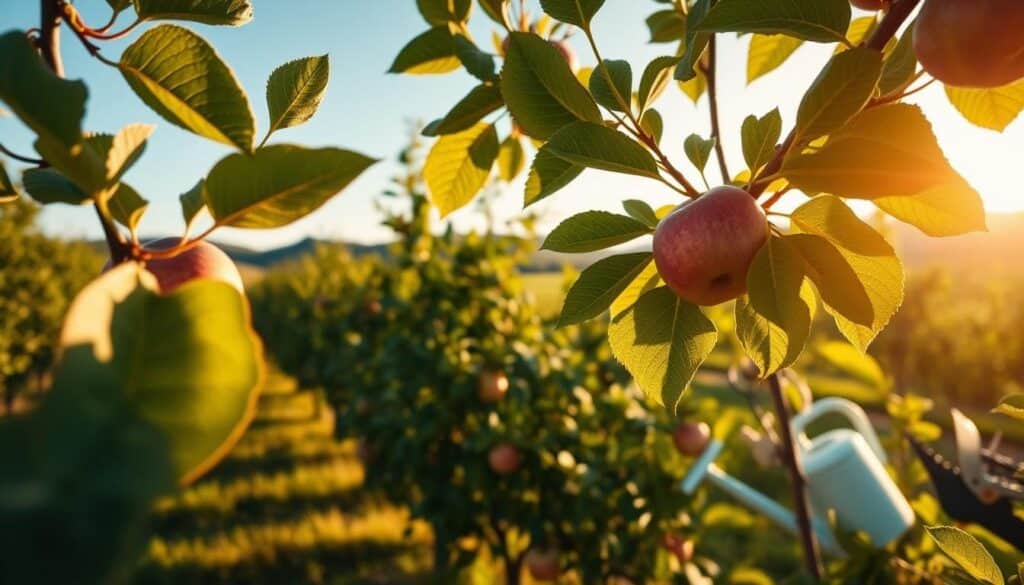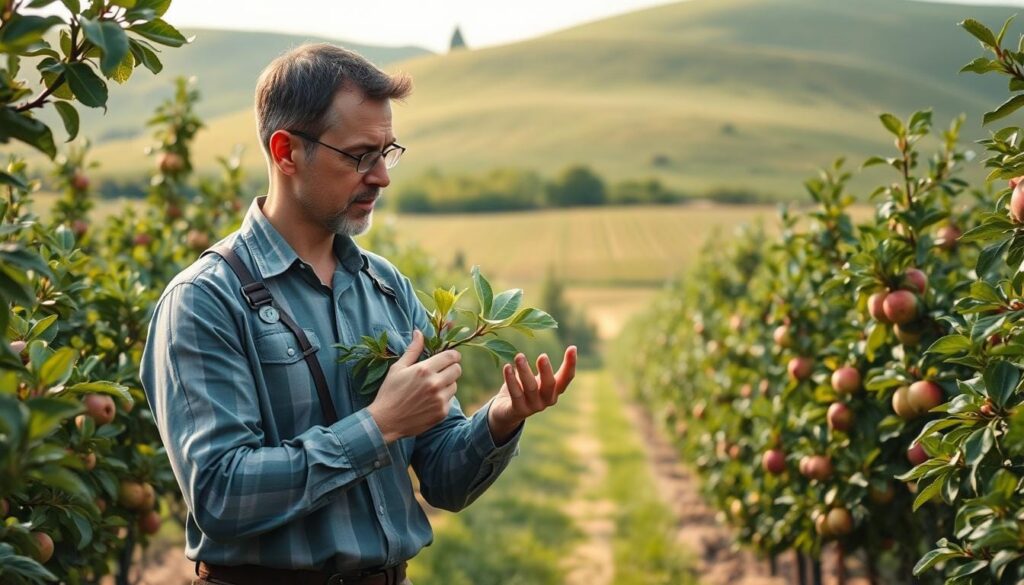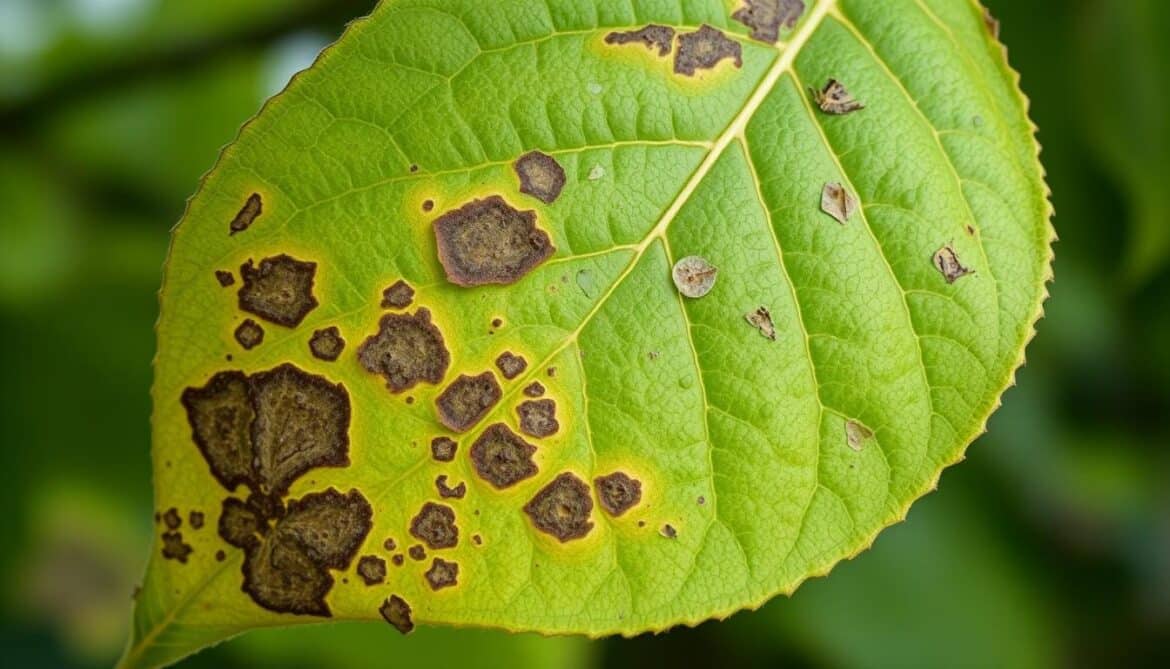In our family orchard, I’ve seen apple trees fight against invisible foes. These diseases can turn a healthy orchard into a battle zone. They quietly harm the trees that give us apples.
Keeping apple trees safe means knowing about leaf diseases. These diseases spread fast and can destroy whole orchards if not stopped. They include apple scab and fungal infections, which need careful watching and action.
Farmers and gardeners must spot these diseases early. Catching apple scab and other diseases early can save a harvest. It can prevent a total loss of crops.
Key Takeaways
- Apple tree diseases can cause complete defoliation by early summer
- Early detection is key to stopping widespread infection
- Different diseases need specific ways to prevent and treat them
- Environmental conditions play a big role in disease growth
- Regular tree checks are vital for keeping orchards healthy
Understanding Apple Tree Leaves Disease
Apple tree diseases can harm the health and fruit production of trees. These diseases make it hard for trees to grow and stay healthy. It’s important for orchard owners and gardeners to know about these diseases.
Apple trees face many leaf diseases. Fire blight and powdery mildew are common. They can spread fast and cause a lot of damage if not treated.
What Are Apple Tree Leaves Diseases?
Leaf diseases harm apple tree leaves, stopping them from making food and weakening the tree. These diseases show in different ways:
- Discoloration of leaves
- Unusual spotting or blotches
- Premature leaf drop
- Stunted growth
Importance of Healthy Apple Tree Foliage
Healthy leaves are vital for apple trees. They help with:
- Photosynthesis and nutrient production
- Fruit development
- Tree’s immune response
- Overall tree strength
Fire blight can be very harmful, damaging trees if not treated fast. Powdery mildew is less severe but can also harm fruit quality. Spotting and treating diseases early is key to keeping apple trees healthy.
Healthy leaves are the foundation of a thriving apple tree ecosystem.
Common Symptoms of Apple Tree Leaves Diseases
Spotting disease symptoms in apple trees is key to keeping them healthy. Knowing the early signs helps gardeners and orchard owners act fast. This way, they can save their trees from serious harm.
Discoloration in Leaves
Leaf color changes often mean disease is present. Cedar apple rust shows up as yellowish-orange spots. Frogeye leaf spot makes dark circular marks. These signs can mean your apple trees are sick.
- Yellow to orange spots indicating cedar apple rust
- Dark brown circular lesions characteristic of frogeye leaf spot
- Unusual green or brownish patches on leaf surfaces
Wilting and Curling
Wilting and curling leaves are big warning signs. If leaves start to twist or droop, it might be a fungal infection or pest stress.
- Leaves curling inward or becoming crisp
- Sudden drooping of previously healthy foliage
- Branches showing signs of reduced vigor
Spots and Blotch Patterns
Spot patterns can tell you a lot about diseases. Cedar apple rust makes complex patterns. Frogeye leaf spot creates clear circular marks that harm leaves.
Early detection is key to preventing widespread disease transmission in apple orchards.
Knowing these symptoms helps gardeners catch and fix health problems early. This way, they can save their trees from serious damage.
Major Causes of Apple Tree Leaves Diseases
Apple tree leaf diseases come from many factors. These include biological and environmental ones. Knowing these causes is key to keeping orchards healthy and preventing damage to fruit trees.
Many things can lead to apple tree leaf diseases. This makes it hard to keep trees healthy and fruit production up. By knowing the main causes, growers can find ways to prevent and manage these issues.
Fungal Infections
Fungal infections are a big problem for apple trees. Diseases like alternaria blotch and sooty blotch can spread fast. They damage leaves and fruit a lot.
- Alternaria blotch creates dark, circular lesions on leaves
- Sooty blotch produces dark, superficial fungal growth
- Spores can travel through wind and water
- Moisture and humidity accelerate fungal growth
Bacterial Infections
Bacteria can get into apple trees in many ways. They can enter through wounds, natural openings, and when the tree is stressed. These tiny invaders harm the tree by attacking its cells and weakening its defenses.
- Bacterial infections often enter through pruning cuts
- Wet conditions increase bacterial spread
- Some bacteria can cause systemic tree damage
Pest Infestations
Insects are important in spreading diseases and weakening apple trees. They can carry pathogens, make it easier for infections to get in, and damage the tree directly.
- Aphids can spread viral diseases
- Sawfly larvae cause fruit and leaf damage
- Codling moths create vulnerabilities in tree structure
To manage these diseases well, we need a plan that covers all bases. This plan should include prevention and specific actions to tackle each problem.
Identification of Specific Diseases
Apple trees face many diseases that harm their health and fruit. Knowing these diseases helps protect trees. Spotting them early is key to treating them right.
Apple Scab: A Widespread Fungal Challenge
Apple scab is a common disease caused by Venturia inaequalis. It’s a big problem for apple growers everywhere. It makes leaves turn olive-green to brown and can cause leaves to fall off early.
- Olive-green to brown spots on leaves
- Lesions up to 1/2 inch across
- Premature leaf drop by midsummer
- Potential total foliage loss
Some apples like ‘Enterprise’ and ‘Liberty’ resist scab. But ‘McIntosh’ is very vulnerable. The apple mosaic virus can also harm leaves, so watching them closely is important.
Powdery Mildew: The White Coating Menace
Powdery mildew, caused by Podosphaera leucotricha, makes leaves look white. It likes shady spots and can stunt tree growth. Phytophthora rot can make things worse by harming the roots.
Fire Blight: A Destructive Bacterial Infection
Fire blight is a big threat to apple trees. It spreads fast when it’s warm and humid. It makes branches look burned.
- Rapidly spreading in rainy conditions
- High humidity accelerates infection
- Can lead to significant tree damage
Keeping an eye on trees and acting fast is the best way to fight these diseases.
Impact of Environmental Factors
It’s important to understand how environmental conditions affect apple tree leaf health. This knowledge helps prevent apple tree leaves disease. The environment greatly influences how likely a tree is to get sick and how fast the disease spreads.
Effects of Weather on Leaf Health
Weather greatly affects apple tree leaves disease. Certain temperatures and humidity levels are perfect for disease growth:
- Optimal temperature for disease spore release: 59-68°F
- Incubation period for symptoms: 3-12 days
- Disease growth significantly inhibited below 50°F and above 86°F
Soil Quality and Nutrient Deficiency
Poor soil can weaken apple trees, making them more prone to disease. Nutrient deficiencies weaken the tree’s defenses, making it easier for infections to take hold.
Key factors for tree health include:
- Soil drainage efficiency
- Nutrient balance
- Organic matter content
- pH levels
Maintaining optimal soil conditions is essential for preventing disease and promoting robust apple tree growth.
Prevention of Apple Tree Leaves Disease
Keeping apple trees safe from diseases like apple scab and fire blight is key. It starts with knowing how to lower risks through good care and maintenance.

Stopping leaf diseases needs many smart steps to keep trees healthy and fruiting well. Starting early with the right actions can greatly cut down disease risks.
Importance of Proper Planting Techniques
Good planting is the first step in disease prevention. Choosing the right spot and spacing trees right is vital for their health.
- Select disease-resistant apple tree varieties
- Ensure adequate spacing between trees for air circulation
- Choose planting sites with excellent drainage
- Avoid low-lying areas prone to moisture accumulation
Role of Pruning in Disease Prevention
Pruning is key in fighting apple scab and fire blight. Regular pruning keeps trees healthy and stops diseases from spreading.
- Remove dead or diseased branches immediately
- Trim branches to improve air circulation
- Use sterilized pruning tools to prevent pathogen spread
- Prune during dry weather conditions
“Prevention is always more effective than cure in apple tree care.” – Expert Arborist
By using these detailed prevention steps, gardeners and orchardists can shield their apple trees from harmful leaf diseases.
Treatment Options for Affected Trees
Apple tree diseases can harm tree health and fruit production. It’s important to use effective treatments to keep trees healthy and productive. Gardeners and orchard owners need to know about chemical and organic disease management.
To treat apple tree leaf diseases, a detailed plan is needed. This plan must address specific conditions and types of pathogens. Each disease requires a unique approach to stop its spread and protect the tree.
Chemical Treatments and Fungicides
Chemical treatments are key in fighting diseases like powdery mildew and cedar apple rust. Using fungicides correctly can control fungal infections effectively.
- Apply sulfur-based fungicides in early spring
- Use copper-based sprays for bacterial infections
- Implement systemic fungicides for persistent issues
Organic Solutions for Disease Control
Organic methods are good for the environment and help manage apple tree diseases. They focus on prevention and natural treatments.
| Disease | Organic Treatment | Application Method |
|---|---|---|
| Powdery Mildew | Potassium Bicarbonate Solution | Spray every 7-10 days |
| Cedar Apple Rust | Neem Oil | Weekly foliar application |
| Fire Blight | Pruning infected branches | Immediate removal |
“Prevention is always better than cure in apple tree disease management.” – Orchard Experts
Using both chemical and organic methods together is the best way to control diseases. Regular checks, proper pruning, and keeping trees healthy are key to preventing leaf diseases.
Role of Integrated Pest Management (IPM)
Integrated Pest Management (IPM) is a detailed way to fight apple tree diseases like frogeye leaf spot and alternaria blotch. It uses many methods together to keep pest numbers low and protect the environment.
Good IPM plans focus on knowing pest systems and using specific actions. Growers can manage diseases well by using different methods that work together.
Combining Biological Control Methods
Biological control is key in fighting apple tree leaf diseases. It includes:
- Introducing natural predators
- Using beneficial insects
- Implementing ecological barriers
- Promoting plant resistance
“In IPM, prevention is always better than cure” – Agricultural Experts
Monitoring and Assessment Techniques
IPM needs careful watching to catch frogeye leaf spot and alternaria blotch early. Important monitoring steps are:
- Regular visual inspections
- Pheromone traps (1 trap per 10 acres)
- Degree-day tracking
- Population sampling methods
Watching closely lets growers act fast to stop diseases from getting worse.
Seasonal Care for Apple Trees
Keeping apple trees healthy needs a careful plan for each season. Each time of year has its own challenges and chances to protect trees from diseases like sooty blotch and apple mosaic virus. Taking good care all year can lower disease risk and keep trees strong.
Managing apple trees well means knowing what they need at different times. Trees face many diseases and stressors that can hurt their health and fruit production.
Spring Maintenance Practices
Spring is key for apple tree care. Here are important steps to take:
- Check trees for winter damage
- Use dormant oil sprays to stop sooty blotch
- Prune bad or crossing branches
- Watch for early signs of apple mosaic virus
Fall Preparations for Disease Prevention
Fall care is vital for protecting apple trees through winter and getting ready for spring:
- Clear fallen leaves and fruit to lower disease risk
- Do a detailed tree check
- Take out any infected branches
- Get trees ready for winter
| Season | Key Maintenance Activities | Disease Prevention Focus |
|---|---|---|
| Spring | Pruning, dormant oil application | Prevent sooty blotch spread |
| Summer | Regular monitoring, irrigation | Identify apple mosaic virus symptoms |
| Fall | Leaf cleanup, branch removal | Reduce overwintering disease risk |
| Winter | Tree protection, planning | Prepare for next growing season |
With a solid seasonal care plan, apple tree owners can handle diseases and keep trees healthy all year.
Importance of Regular Inspections
Keeping apple trees healthy means watching them closely. Regular checks are key to catching phytophthora rot and other diseases early. This stops them from causing big problems.
Good apple tree care means knowing how to spot early signs. These checks stop small problems from getting worse. They help keep your tree strong and healthy.
How to Spot Early Signs of Disease
Finding health issues early needs a careful plan. Here are important signs to look for:
- Unusual leaf discoloration
- Unusual spots or markings on leaves
- Wilting or curling leaf edges
- Unexpected branch dieback
- Presence of white powdery coating
Keeping a Maintenance Log for Trees
Writing down what you see is very helpful. It lets you track your tree’s health over time. A detailed log helps you:
- Track recurring disease patterns
- Monitor tree growth and changes
- Record treatment interventions
- Plan future preventative strategies
| Inspection Frequency | Recommended Actions |
|---|---|
| Spring | Check for new growth, signs of winter damage |
| Summer | Monitor leaf health, watch for pest activity |
| Fall | Assess overall tree condition, prepare for winter |
| Winter | Prune and inspect structural integrity |
Early detection is the best way to manage apple tree health and avoid big disease problems.
Educational Resources for Apple Tree Care
Dealing with apple tree health can be tricky. Whether fighting apple scab or stopping fire blight, the right info is key. Today, there are many ways to learn about caring for apple trees.
There are many learning tools for apple tree lovers. These tools range from books to online sites. They offer the latest on keeping trees healthy.
Books and Guides on Apple Tree Health
Books and guides are great for both pros and hobbyists. They cover topics like:
- How to prevent apple scab
- Integrated pest management
- Scientific studies from extension services
- Guides for local growing areas
Many resources come from universities and extension services. The New Mexico State University publication is a top pick for learning about apple tree care.
Online Resources and Communities
The internet has changed how we learn about apple tree care. Online forums, webinars, and websites offer quick tips on fire blight and more.
- Forums with expert advice
- Webinars from horticulture experts
- Social media groups for fruit tree fans
- Websites with disease identification tools
These online tools give growers the knowledge they need. They help make better choices for tree care and disease control.
Professional Help: When to Call an Expert
Keeping apple trees healthy needs careful watching and quick action. Some diseases can spread fast, making it key to get expert help. Tree health professionals are vital for spotting and fixing tough tree problems.

Knowing when to call for help can save your apple trees from serious diseases. Look out for these warning signs:
- Persistent leaf discoloration or extensive spotting
- Rapid tree decline despite home care efforts
- Unexplained branch dieback or extensive root damage
- Widespread fungal infections affecting multiple branches
Signs Indicating Expert Intervention is Needed
Arborists can spot complex tree health issues that might go unnoticed. Early detection of diseases like cedar apple rust can prevent widespread tree damage. Watch for these signs:
- Unusual leaf distortions or premature leaf drop
- Visible fungal growth on branches or trunk
- Significant insect infestations
- Suspected root system problems
Choosing the Right Arborist or Specialist
Finding the right tree care professional is important. Look for certifications, experience with apple tree diseases, and a holistic approach to tree health.
| Criteria | What to Look For |
|---|---|
| Certification | ISA Certified Arborist |
| Experience | Minimum 5 years in fruit tree care |
| Specialization | Expertise in fruit tree diseases |
| Treatment Approach | Integrated Pest Management |
Investing in professional tree care can prevent long-term damage and ensure your apple trees stay healthy. Regular checks with a certified arborist keep your trees thriving and protect them from diseases like powdery mildew.
Conclusion: Maintaining Healthy Apple Trees
Keeping apple trees healthy means fighting diseases like frogeye leaf spot and alternaria blotch. It’s all about balancing the environment, tree health, and care. This balance can make your apple trees live longer and produce more.
Using smart practices like regular pruning and choosing disease-resistant trees helps a lot. Trees like ‘Liberty’ and ‘Enterprise’ are good choices. Early action against diseases like powdery mildew and fire blight is key.
Home apple growers should use a mix of methods to keep pests away. This includes using natural controls, watching closely, and treating when needed. Good soil, right watering, and watching for disease signs help trees grow well.
Apple tree care is a never-ending learning process. With the right knowledge, gardeners can make their orchards productive and healthy. This leads to plenty of tasty fruit every year.

